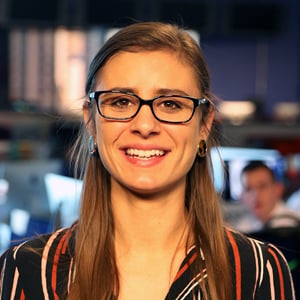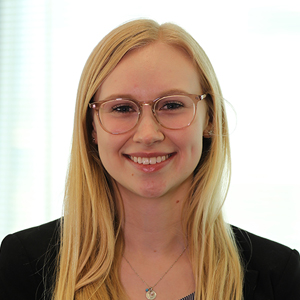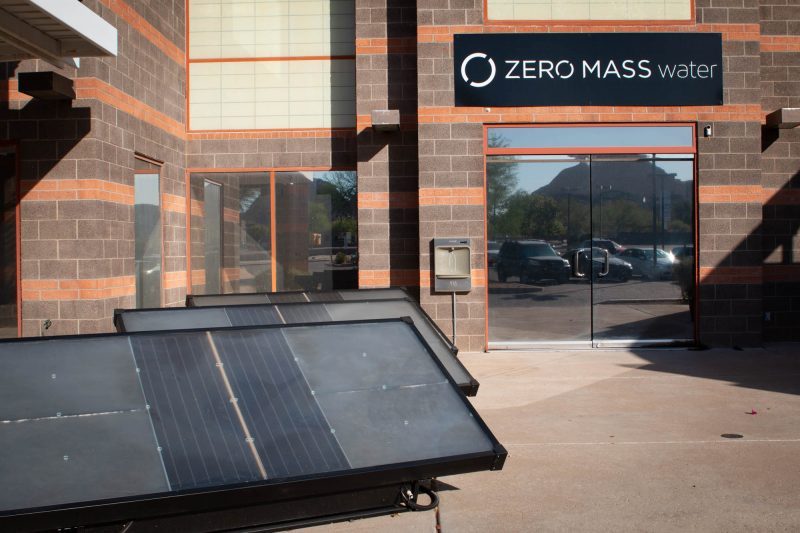
Zero Mass Water has arrays in more than 30 countries. Kaitlyn Fitzgerald, brand director at Zero Mass Water, says having hydropanels “means that you know that every time the sun shines, you’re making water.” (Photo by Delia Johnson/Cronkite News)
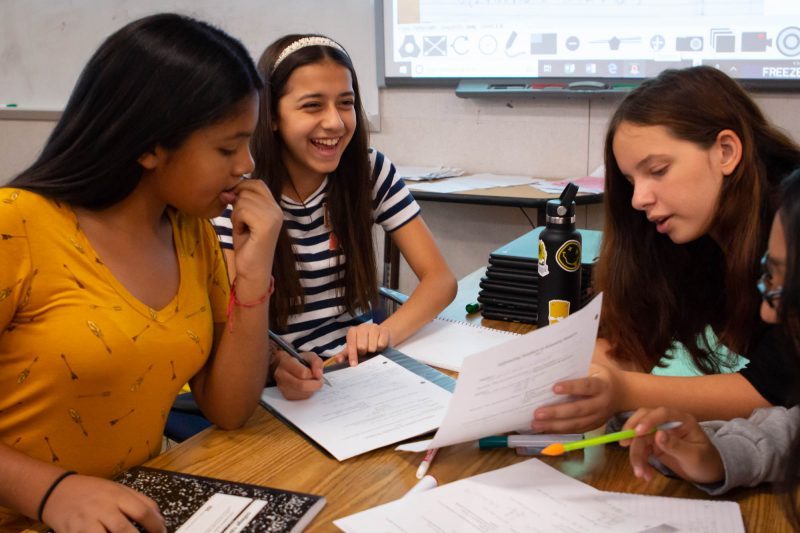
Thirteen-year-olds Sophia Saenz, left, Celeste Rivas, center, and Hailey Kelley check their math at Copper King Elementary in west Phoenix. Rivas says she always has enjoyed performing arts, but since joining the STEAM Academy, she also likes math and science. (Photo by Delia Johnson/Cronkite News)
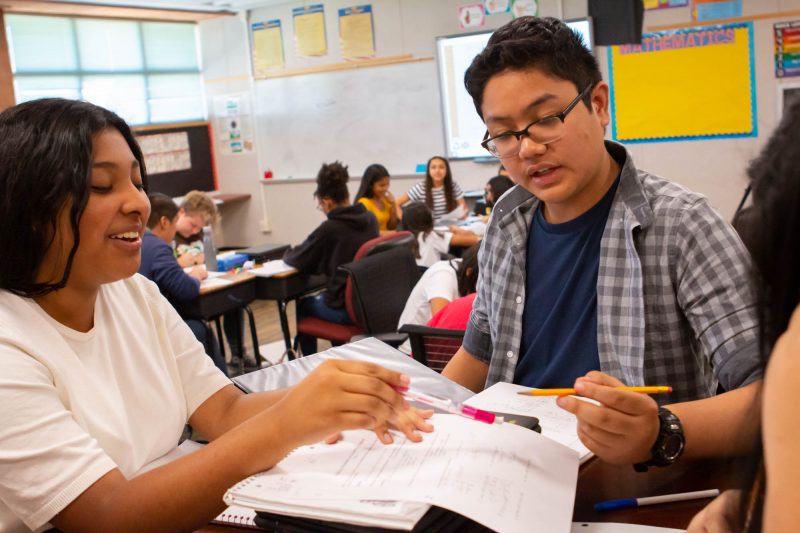
Tristan Pongos, 13, works on math problems with Emily Figuroa, 13, at Copper King Elementary School. “I like the adventure part of it, discovering new things,” says Pongos, who wants to pursue a career in science. (Photo by Delia Johnson/Cronkite News)

A partnership between Zero Mass Water and Copper King Elementary in west Phoenix provides students with clean drinking water and teaches them about renewable energy technology. The company’s website states its mission as “making drinking water an unlimited resource.” (Photo by Delia Johnson/Cronkite News)

Zero Mass Water technology collects moisture from the air. The water flows through underground tubes into a fountain in the STEAM classroom at Copper King Elementary. (Photo by Delia Johnson/Cronkite News)
PHOENIX – Students in Copper King Elementary’s STEAM Academy sit in circles for collaborative learning as their instructor reminds them to use their “brain first, notes second, table third.”
A partnership with the Scottsdale startup Zero Mass Water allows these west Phoenix students to explore the off-grid technology behind the company’s “hydropanels,” which use sunlight to pull water from the air. The students also get to drink the water produced by hydropanels on campus.
“It’s important that every single person knows not only what’s in their water, but also where their water comes from and the impact their water has on the local community and on our world as a whole,” said Kaitlyn Fitzgerald, Zero Mass Water’s brand director.
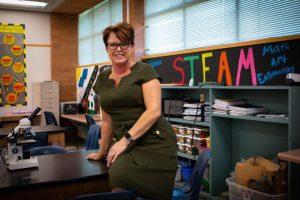
“We’re really trying to teach them to be more aware of how they’re using resources on the planet because they might not be here in their future,” Copper King Elementary School Principal Janine Ambrose says. (Photo by Delia Johnson/Cronkite News)
As global population and temperatures continue to rise, water availability gains urgency. About 3 out of 10 people worldwide do not have access to clean drinking water, according to the World Health Organization, and about half of the global population will be living in areas with water shortages by 2025.
Cody Friesen, an associate professor of engineering and material sciences at Arizona State University, founded Zero Mass Water in 2014. In September, he won the $500,000 Lemelson-MIT Prize, which “recognizes individuals who translate their ideas into inventions that improve the world in which we live.”
The technology, which requires no water or electricity, uses sunlight and air to create potable water in remote locations and even where humidity is low, as it is in Arizona.
Near the far north wall of Copper King’s expansive campus on West Campbell Avenue, two rows of five hydropanels are arrayed outside the STEAM classroom (science, technology, engineering, arts and mathematics). Water produced by the panels is piped into the classroom and dispensed from a fountain.
“I’m really filled with optimism when we provide activities and things like this for kids to be involved in,” said Janine Ambrose, principal of Copper King, adding that education needs to be hands-on so it can build confidence and problem-solving skills in students.
The students were taught about the Zero Mass Water technology when they joined the STEAM program, which highlights renewable resources and encourages young people to consider careers in math and science.
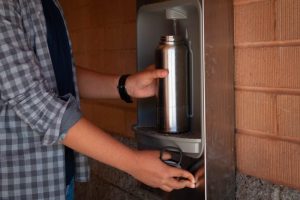
Tristan Pongos, 13, fills a bottle using the Zero Mass water fountain at Copper King Elementary. (Photo by Delia Johnson/Cronkite News)
Celeste Rivas, an eighth-grader in the STEAM program, said exposure to technology like the hydropanels has helped her understand the significance of permanent solutions to pressing issues, like water.
“It’s so important because it’s something you can rely on, and it’s, like, it never dies,” Rivas said. “And it’s so healthy for the community and for yourself that you can always go to it.”
Zero Mass Water locally manufactures SOURCE Hydropanels – SOURCE refers to how the panels produce water from sunlight and air – and engages in local and global partnerships in Australia and South Africa. Arrays are in use in more than 30 countries, the company says.
Zero Mass Water’s website states its mission as “making drinking water an unlimited resource.”
A set of two hydropanels, which costs about $6,000, is enough to supply four to six people. The panels generate enough water to fill 300 to 600 standard-size water bottles per month, depending on sun intensity, humidity and other weather conditions.
“Of course the technology is really exciting,” Fitzgerald said, “but it’s the impact on people’s lives and what they do with the technology that we find really inspiring.”
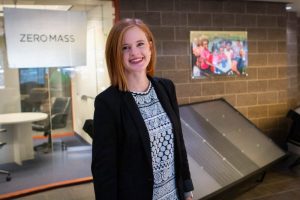
“It’s important that every single person knows not only what’s in their water, but also where their water comes from and the impact their water has on the local community and on our world as a whole,” says Kaitlyn Fitzgerald, brand director for Zero Mass Water. (Photo by Delia Johnson/Cronkite News)
Grant funding from donors is one of the ways the company’s partnerships allow underserved populations to gain access to the technology, she said.
After Hurricane Maria in 2017, Zero Mass Water deployed hydropanels at fire stations in Puerto Rico for use by first responders and the public.
In Australia, which is experiencing serious drought, 80% of the available water is used each year. Patty Mills, a Canberra native who plays for the NBA San Antonio Spurs, recently partnered with Zero Mass Water to bring hydropanels to six indigenous communities.
Fitzgerald said as water scarcity increases, companies should be aware of “the role they fit in the world.”
“As a water company we’re looking at the issues that exist around water – water scarcity, water contamination, infrastructure – and we’re always trying to innovate new ways that the technology we’ve developed is a solution,” she said.
Friesen contributed to an opinion column in The Hill in October and suggested the challenges surrounding water would be easier dealt with one at a time.
“We are lucky to be living at a time when technological advancements are accelerating,” he wrote. “The advent of so much new science in this area means that almost nothing is impossible. If we can apply the global brain trust and the best parts of the human imagination to the global water problem, we can solve it.”
